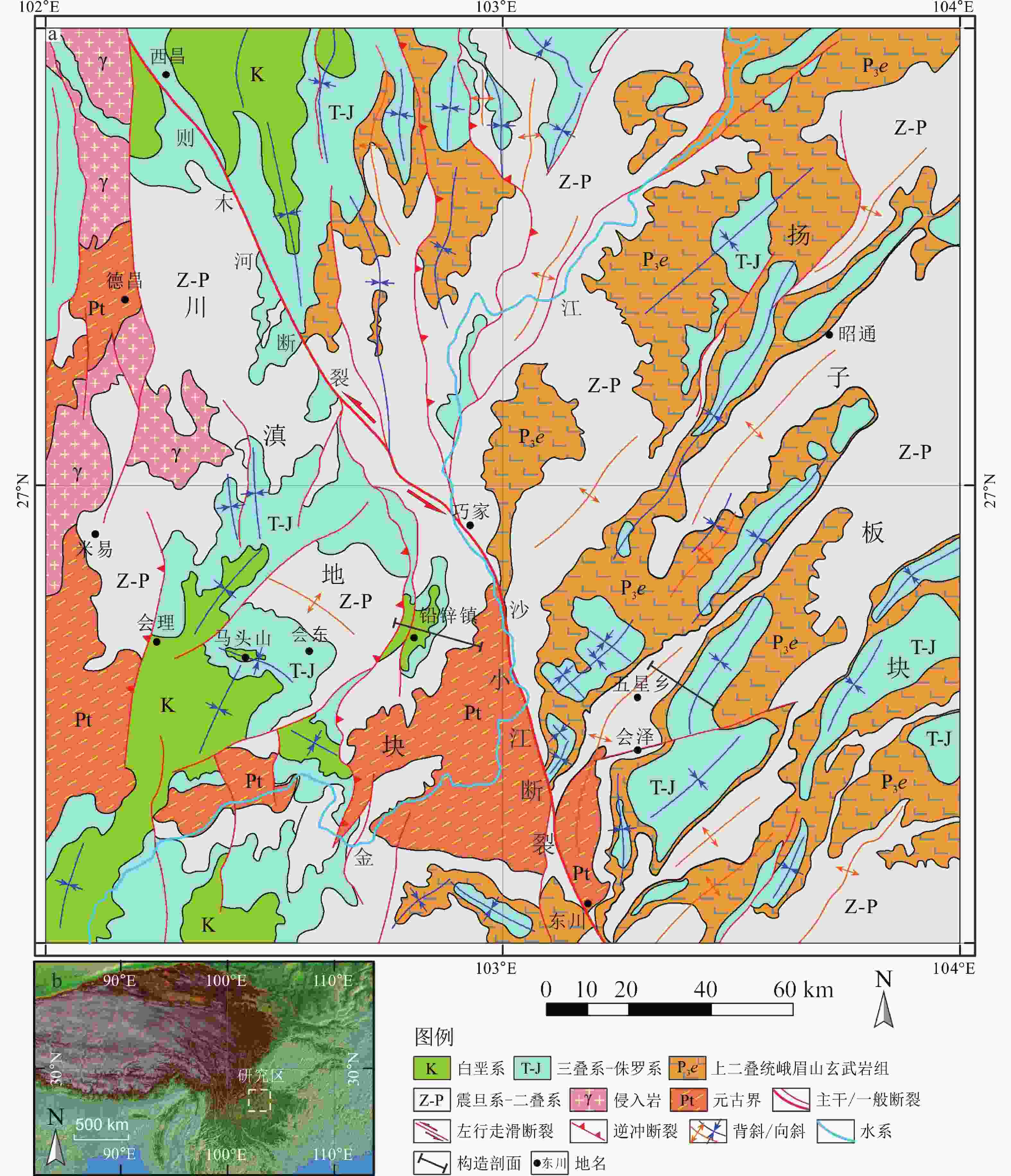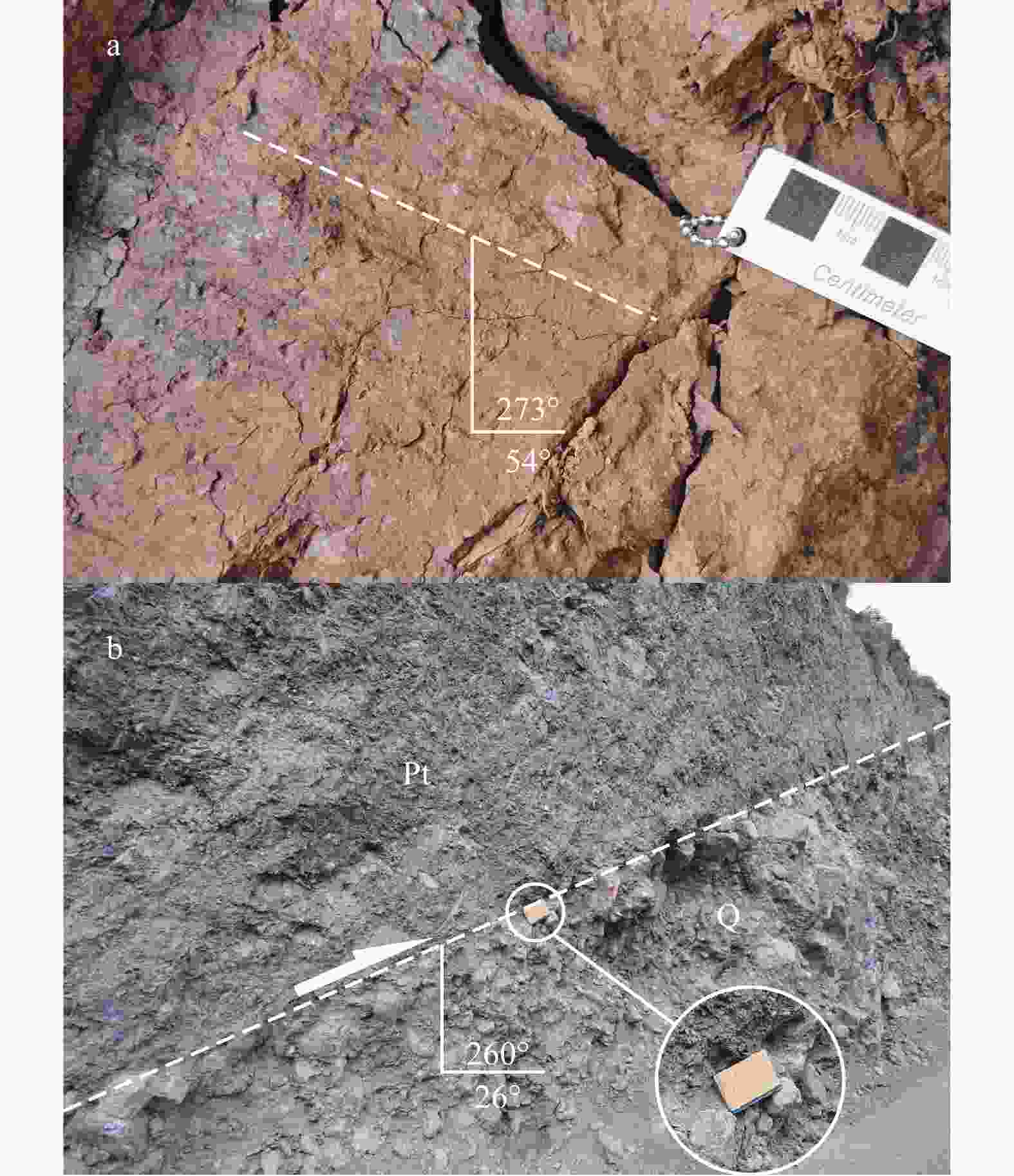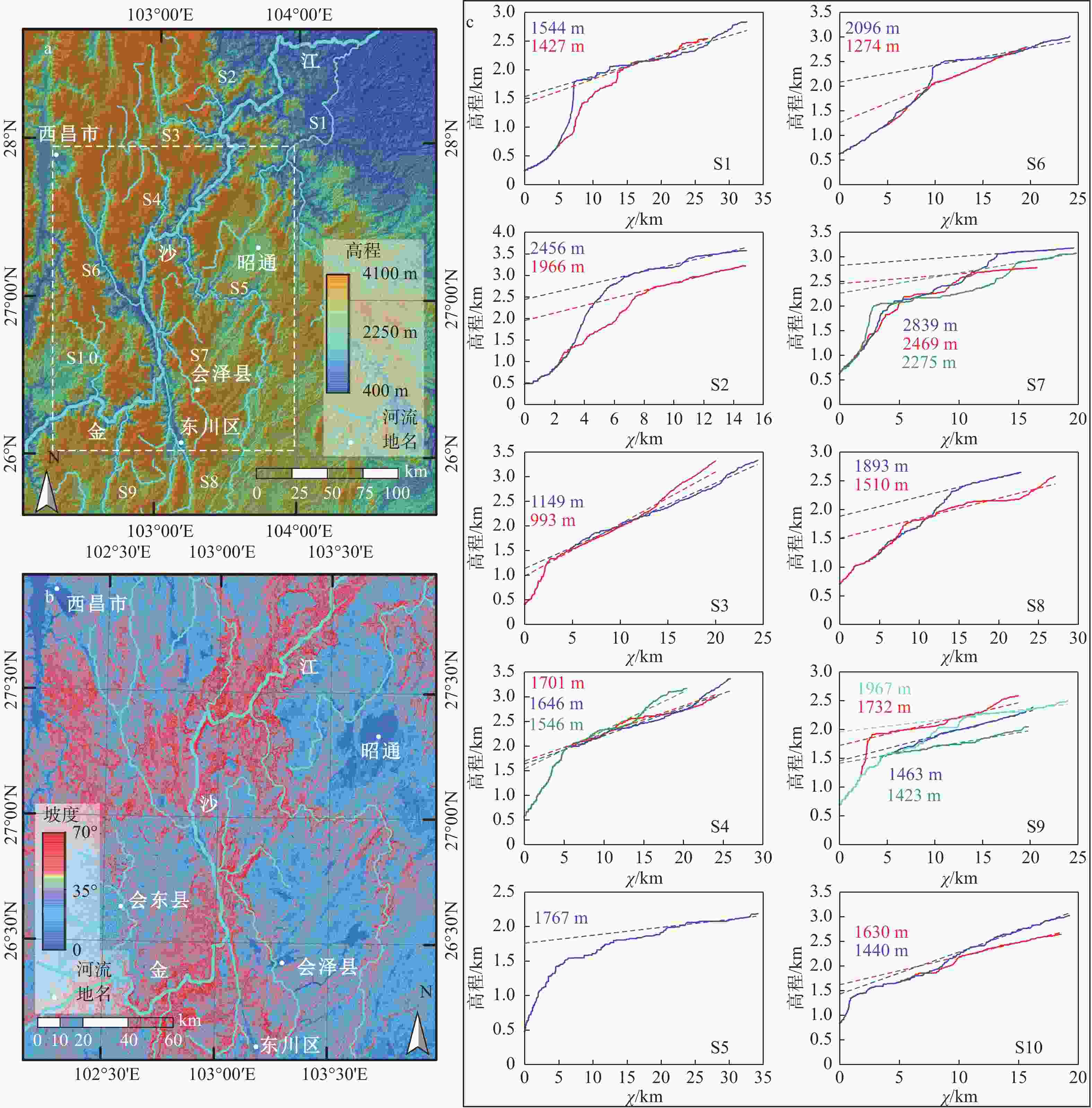Cenozoic tectonics and geomorphic evolution of the lower Jinsha River on the southeastern margin of the Tibetan Plateau
-
摘要:
青藏高原东南缘发育数十万平方千米的广阔地貌过渡带与大面积低起伏地貌面,独特的地貌提供了解读高原构造拓展与地表隆升时间、过程以及机制的理想窗口。为揭示青藏高原东南缘新生代构造变形响应和地貌演化过程,通过构造解析、构造地貌以及低温热年代学数据分析对金沙江下游流域进行综合研究。结果表明青藏高原东南缘早在始新世即已处于北西向为主的区域性挤压条件下而发生广泛褶皱变形。尽管始新世存在区域性变形响应,但青藏高原东南缘金沙江下游地区在古近纪为低海拔丘陵地貌,地表隆升幅度极为有限。晚渐新世—早中新世研究区总体处于长期的低剥蚀速率环境,促进了低海拔平缓地貌的形成。晚新近纪以来,青藏高原东南缘发生区域性缩短变形与显著地表隆升,大型水系同步下蚀,共同塑造形成现今较高海拔的低起伏地貌面与深切峡谷并存的特征性地貌。研究结果支持青藏高原东南缘晚新近纪以来的隆升与地壳构造缩短及增厚密切相关,而中下地壳塑性流动增厚机制并非必不可少。
Abstract:The southeastern margin of the Tibetan Plateau is distinguished by a vast transition zone with hundreds of thousands of square kilometers of low-relief surfaces, which provides an ideal window for unraveling the timing, process, and mechanisms of the tectonic propagation and surface uplift. In order to reveal the Cenozoic tectonic response and geomorphic evolution of the southeastern margin of the Tibetan Plateau, a comprehensive study in the lower Jinsha River was conducted with a tectonic investigation, tectonic-landform and low-temperature thermochronological data analysis. The results show that the southeastern margin of the Tibetan Plateau remained in NW-shortening as early as the Eocene, forming widespread folds. However, we suggest that in the Paleogene, the lower Jinsha River of the southeastern margin of the Tibetan Plateau was marked by a low hilly topography with rather limited surface uplift. In the Late Oligocene–Early Miocene, the study area was characterized by a long-term stage with low denudation rates, which promoted the formation of widespread low-relief surfaces. Since the late Neogene, the southeastern margin of the Tibetan Plateau has undergone regional shortening deformation and significant surface uplift with a simultaneous incision along large rivers, forming the present landforms characterized by high-elevation low-relief surfaces and deep gorges. The late Neogene surface uplift across the southeastern margin of the Tibetan Plateau is suggested to be closely related to the shortening deformation and associated crustal thickening. In contrast, the mid-lower crustal thickening by channel flow might not be indispensable.
-
图 1 青藏高原东南缘金沙江下游会理−昭通地区地质构造简图
a—地质构造简图;b—研究区地理位置
Figure 1. Simplified geologic and structural map of the Huili–Zhaotong area in the lower Jinsha River of the southeastern margin of the Tibetan Plateau
(a) Simplified geologic and structural map; (b) Location of the study area on the southeastern margin of the Tibetan Plateau
图 2 金沙江下游北东向与近南北向构造(剖面位置见图1)及其赤平投影
Pt—会理群变质褶皱基底;Zd—震旦系灯影组;Є1q-c—下寒武统筇竹寺组—沧浪铺组;Є-O—寒武系—奥陶系;D2-C2—中泥盆统—中石炭统;P1-2—下二叠统—中二叠统;P3e—上二叠统峨眉山玄武岩组;T1-3—下三叠统—上三叠统;T3J1bg—上三叠统—下侏罗统白果湾组;J1-2—下侏罗统—中侏罗统;J2y—中侏罗统益门组;K1x—下白垩统小坝组;其他岩石地层单元未细分。图中赤平投影显示褶皱翼部岩层产状与弯滑线理,箭头代表区域性主应力方向。a—会泽五星乡褶皱构造剖面;b—铅锌镇褶皱逆冲构造剖面
Figure 2. NE-trending and near SN-trending structures in the lower Jinsha River (See Fig. 1 for section locations) and their stereographic projections
(a) Fold section across Wuxing Village in Huize; (b) Fold-thrust section across Qianxin Town Pt–Folded basement of the Huili Group; Zd–Sinian Dengying Formation; Є1q-c–Lower Cambrian Qiongzhusi Formation–Canglangpu Formation; Є-O–Cambrian–Ordovician; D2-C2–Middle Devonian–Middle Carboniferous; P1-2–Lower–Middle Permian; P3e–Upper Permian Emeishan Basalt Formation; T1-3–Lower–Upper Triassic; T3J1bg–Upper Triassic–Lower Jurassic Baiguowan Formation; J1-2–Lower–Middle Jurassic; J2y–Middle Jurassic Yimen Formation; K1x–Lower Cretaceous Xiaoba Formation; Alternative lithostratigraphic units are undivided. The stereographic projections show attitudes of limb beddings and fold-slip lineations, and arrows indicate regional principal stresses.
图 3 研究区近东西向挤压变形
a—铅锌镇北北东向向斜翼部小坝组近东西向顺层弯滑线理;b—侵入会理群的变质闪长岩向东低角度逆冲至金沙江河道砾石层之上
Figure 3. Near EW-trending shortening deformation observed in the study area
(a) Fold-slip lineations developed on the Xiaoba Formation in the limb of the NNE-trending syncline across Qianxin Town; (b) The metamorphosed diorite intruded in the Huili Group being thrusted eastward above the fluvial gravels of the Jinsha River
图 4 金沙江下游会理−昭通地区数字高程地形、坡度分布以及主干支流纵剖面χ图解
a—研究区数字地形及主干水系;b—研究区坡度与主干水系分布,坡度分布显示研究区低起伏地貌面与陡边坡地貌的突变界线,坡度分析区域为图4a中白色虚线范围;c—主干支流χ纵剖面图解,河流纵剖面χ图解中不同颜色曲线代表不同的支流,数字表示相应河流纵剖面的投影高度,作为地表隆升幅度的指标,河流位置及编号详见图4a
Figure 4. Digital elevation topography, slope distribution in the Huili–Zhaotong area of the lower Jinsha River and χ plots of longitudinal profiles of the main tributaries
(a) Digital elevation topography and major tributaries of the study area; (b) Slope distribution with major tributaries. Note the abrupt boundary between the low-relief area and the steep hillslopes. See Fig. 4a for the analyzed area indicated by the white dashed box; (c) χ plots of the longitudinal profiles analyzed. Colors are used to distinguish distinctive tributaries, and the numbers marked indicate the projected stream heights, representing magnitudes of surface uplift. See Fig. 4a for tributary labels and locations.
图 5 青藏高原东南缘川滇地块区热年代学冷却年龄直方图(数据引自Xu and Kamp,2000;Clark et al., 2005b;来庆洲等,2006;安艳芬等,2008;谭锡斌等,2010; Ouimet et al.,2010;Wilson and Fowler,2011;Wang et al., 2012, 2017, 2022; Tian et al., 2014, 2015;Tan et al., 2014;Deng et al., 2015, 2018b;Zhang et al., 2015, 2016, 2017, 2022;Meng et al., 2016;Yang et al., 2016, 2020;Shen et al., 2016, 2022; Liu-Zeng et al., 2018;Cao et al., 2019;Replumaz et al., 2020;Gourbet et al., 2020;Zhu et al., 2021;Pitard et al., 2021;Tao et al., 2022;Lei et al., 2022)
a—磷灰石(U-Th)/He年龄直方图;b—锆石(U-Th)/He年龄直方图;c—磷灰石裂变径迹年龄直方图;d—锆石裂变径迹年龄直方图
Figure 5. Histogram of thermochronological cooling ages in the Sichuan–Yunnan Block area of the southeastern margin of the Tibetan Plateau (Data after Xu and Kamp, 2000; Clark et al., 2005b; Lai et al., 2006; An et al., 2008; Tan et al., 2010; Ouimet et al.,2010; Wilson and Fowler, 2011; Wang et al., 2012, 2017, 2022; Tian et al., 2014, 2015; Tan et al., 2014; Deng et al., 2015, 2018b; Zhang et al., 2015, 2016, 2017, 2022; Meng et al., 2016; Yang et al., 2016, 2020; Shen et al., 2016, 2022; Liu-Zeng et al., 2018; Cao et al., 2019; Replumaz et al., 2020; Gourbet et al., 2020; Zhu et al., 2021; Pitard et al., 2021; Tao et al., 2022; Lei et al., 2022)
(a) Apatite (U-Th)/He cooling-age histogram; (b) Zircon (U-Th)/He cooling-age histogram; (c) Apatite fission-track cooling-age histogram; (d) Zircon fission-track cooling-age histogram
-
[1] AN Y F, HAN Z J, WAN J L, 2008. Fission track dating of the Cenozoic uplift in Mabian area, southern Sichuan Province, China[J]. Science in China Series D: Earth Sciences, 51(9): 1238-1247. doi: 10.1007/s11430-008-0105-5 [2] AN Z S, WU G X, LI J P, et al. , 2015. Global monsoon dynamics and climate change[J]. Annual Review of Earth and Planetary Sciences, 43: 29-77. doi: 10.1146/annurev-earth-060313-054623 [3] BURCHFIEL B C, CHEN Z L, LIU Y, et al. , 1995. Tectonics of the Longmen Shan and adjacent regions, central China[J]. International Geology Review, 37(8): 661-735. doi: 10.1080/00206819509465424 [4] CAO K, WANG G C, LELOUP P H, et al. , 2019. Oligocene-early Miocene topographic relief generation of southeastern Tibet triggered by thrusting[J]. Tectonics, 38(1): 374-391. doi: 10.1029/2017TC004832 [5] CAO P J, CHENG S Y, LIN H X, et al. , 2021. DEM in quantitative analysis of structural geomorphology: application and prospect[J]. Journal of Geomechanics, 27(6): 949-962. (in Chinese with English abstract) [6] CLARK M K, ROYDEN L H, 2000. Topographic ooze: building the eastern margin of Tibet by lower crustal flow[J]. Geology, 28(8): 703-706. doi: 10.1130/0091-7613(2000)28<703:TOBTEM>2.0.CO;2 [7] CLARK M K, BUSH J W M, ROYDEN L H, 2005a. Dynamic topography produced by lower crustal flow against rheological strength heterogeneities bordering the Tibetan Plateau[J]. Geophysical Journal International, 162(2): 575-590. doi: 10.1111/j.1365-246X.2005.02580.x [8] CLARK M K, HOUSE M A, ROYDEN L H, et al. , 2005b. Late Cenozoic uplift of southeastern Tibet[J]. Geology, 33(6): 525-528. doi: 10.1130/G21265.1 [9] DENG B, LIU S G, ENKELMANN E, et al. , 2015. Late Miocene accelerated exhumation of the Daliang Mountains, southeastern margin of the Tibetan Plateau[J]. International Journal of Earth Sciences, 104(4): 1061-1081. doi: 10.1007/s00531-014-1129-z [10] DENG B, CHEW D, JIANG L, et al. , 2018a. Heavy mineral analysis and detrital U-Pb ages of the intracontinental Paleo-Yangzte basin: Implications for a transcontinental source-to-sink system during Late Cretaceous time[J]. GSA Bulletin, 130(11-12): 2087-2109. doi: 10.1130/B32037.1 [11] DENG B, LIU S G, JIANG L, et al. , 2018b. Tectonic uplift of the Xichang Basin (SE Tibetan Plateau) revealed by structural geology and thermochronology data[J]. Basin Research, 30(1): 75-96. doi: 10.1111/bre.12243 [12] GOURBET L, YANG R, FELLIN M G, et al. , 2020. Evolution of the Yangtze River network, southeastern Tibet: Insights from thermochronology and sedimentology[J]. Lithosphere, 12(1): 3-18. doi: 10.1130/L1104.1 [13] GUO Z W, DENG K L, HAN Y H, et al. , 1996. The formation and development of Sichuan Basin[M]. Beijing: Geology Press: 48-82. (in Chinese) [14] HAN M M, CHEN L C, ZENG D, et al. , 2022. Discussion on the latest surface ruptures near the Zhonggu village along the Selaha segment of the Xianshuihe fault zone[J]. Journal of Geomechanics, 28(6): 969-980. (in Chinese with English abstract) [15] HE D F, LI Y Q, HUANG H Y, et al. , 2020. Formation and evolution of the polycyclic superimposed Sichuan Basin and hydrocarbon accumulation[M]. Beijing: Science Press: 98-120. (in Chinese) [16] HE S L, DING L, XIONG Z Y, et al. , 2022. A distinctive Eocene Asian monsoon and modern biodiversity resulted from the rise of eastern Tibet[J]. Science Bulletin, 67(21): 2245-2258. doi: 10.1016/j.scib.2022.10.006 [17] HOKE G D, LIU-ZENG J, HREN M T, et al. , 2014. Stable isotopes reveal high southeast Tibetan Plateau margin since the Paleogene[J]. Earth and Planetary Science Letters, 394: 270-278. doi: 10.1016/j.jpgl.2014.03.007 [18] HOKE G D, 2018. Geochronology transforms our view of how Tibet’s southeast margin evolved[J]. Geology, 46(1): 95-96. doi: 10.1130/focus012018.1 [19] KIRBY E, WHIPPLE K X, 2012. Expression of active tectonics in erosional landscapes[J]. Journal of Structural Geology, 44: 54-75. doi: 10.1016/j.jsg.2012.07.009 [20] LAI Q Z, DING L, WANG H W, et al. , 2006. Constraining the stepwise migration of the eastern Tibetan Plateau margin by apatite fission track thermochronology[J]. Science in China Series D: Earth Sciences, 50(2): 172-183. [21] LEI H J, SHEN X M, LIU X J, et al. , 2022. Oligocene-early Miocene rapid exhumation along the Xianshuihe fault system: Implications for the growth of the Southeastern Tibetan Plateau[J]. Journal of Asian Earth Sciences, 240: 105443. doi: 10.1016/j.jseaes.2022.105443 [22] LELOUP P H, LACASSIN R, TAPPONNIER P, et al. , 1995. The Ailao Shan-red river shear zone (Yunnan, China), tertiary transform boundary of Indochina[J]. Tectonophysics, 251(1-4): 3-84. doi: 10.1016/0040-1951(95)00070-4 [23] LELOUP P H, ARNAUD N, LACASSIN R, et al. , 2001. New constraints on the structure, thermochronology, and timing of the Ailao Shan-Red River shear Zone, SE Asia[J]. Journal of Geophysical Research: Solid Earth, 106(B4): 6683-6732. doi: 10.1029/2000JB900322 [24] LI S Y, CURRIE B S, ROWLEY D B, et al. , 2015. Cenozoic paleoaltimetry of the SE margin of the Tibetan Plateau: Constraints on the tectonic evolution of the region[J]. Earth and Planetary Science Letters, 432: 415-424. doi: 10.1016/j.jpgl.2015.09.044 [25] LIU-ZENG J, TAPPONNIER P, GAUDEMER Y, et al. , 2008. Quantifying landscape differences across the Tibetan plateau: Implications for topographic relief evolution[J]. Journal of Geophysical Research: Earth Surface, 113(F4): F04018. [26] LIU-ZENG J, ZHANG J Y, MCPHILLIPS D, et al. , 2018. Multiple episodes of fast exhumation since Cretaceous in southeast Tibet, revealed by low-temperature thermochronology[J]. Earth and Planetary Science Letters, 490: 62-76. doi: 10.1016/j.jpgl.2018.03.011 [27] MENG K, WANG E, WANG G, 2016. Uplift of the Emei Shan, western Sichuan Basin: implication for eastward propagation of the Tibetan Plateau in early Miocene[J]. Journal of Asian Earth Sciences, 115: 29-39. doi: 10.1016/j.jseaes.2015.09.020 [28] OUIMET W, WHIPPLE K, ROYDEN L, et al. , 2010. Regional incision of the eastern margin of the Tibetan Plateau[J]. Lithosphere, 2(1): 50-63. doi: 10.1130/L57.1 [29] PERRON J T, ROYDEN L, 2013. An integral approach to bedrock river profile analysis[J]. Earth Surface Processes and Landforms, 38(6): 570-576. doi: 10.1002/esp.3302 [30] PITARD P, REPLUMAZ A, CHEVALIER M L, et al. , 2021. Exhumation history along the Muli thrust—implication for crustal thickening mechanism in Eastern Tibet[J]. Geophysical Research Letters, 48(14): e2021GL093677. [31] REPLUMAZ A, SAN JOSÉ M, MARGIRIER A, et al. , 2020. Tectonic control on rapid late Miocene—quaternary incision of the Mekong river Knickzone, Southeast Tibetan Plateau[J]. Tectonics, 39(2): e2019TC005782. [32] ROGER F, CALASSOU S, LANCELOT J, et al. , 1995. Miocene emplacement and deformation of the Konga Shan granite (Xianshui He fault zone, west Sichuan, China): geodynamic implications[J]. Earth and Planetary Science Letters, 130(1-4): 201-216. doi: 10.1016/0012-821X(94)00252-T [33] ROYDEN L H, BURCHFIEL B C, VAN DER HILST R D, 2008. The geological evolution of the Tibetan Plateau[J]. Science, 321(5892): 1054-1058. doi: 10.1126/science.1155371 [34] SHEN X M, TIAN Y T, LI D W, et al. , 2016. Oligocene-early Miocene river incision near the first bend of the Yangze River: Insights from apatite (U-Th-Sm)/He thermochronology[J]. Tectonophysics, 687: 223-231. doi: 10.1016/j.tecto.2016.08.006 [35] SHEN X M, BRAUN J, YUAN X P, 2022. Southeastern margin of the Tibetan Plateau stopped expanding in the late Miocene[J]. Earth and Planetary Science Letters, 583: 117446. doi: 10.1016/j.jpgl.2022.117446 [36] SU T, SPICER R A, LI S H, et al. , 2018. Uplift, climate and biotic changes at the Eocene–Oligocene transition in south-eastern Tibet[J]. National Science Review, 6(3): 495-504. [37] TAN X B, XU X W, LI Y X, et al. , 2010. Apatite fission track evidence for rapid uplift of the Gongga Mountain and discussion of its mechanism[J]. Chinese Journal of Geophysics, 53(8): 1859-1867. (in Chinese with English abstract) [38] TAN X B, LEE Y H, CHEN W Y, et al. , 2014. Exhumation history and faulting activity of the southern segment of the Longmen Shan, eastern Tibet[J]. Journal of Asian Earth Sciences, 81: 91-104. doi: 10.1016/j.jseaes.2013.12.002 [39] TAO Y L, ZHANG H P, ZHANG J W, et al. , 2022. Late cretaceous–early Cenozoic exhumation across the Yalong thrust belt in eastern Tibet and its implications for outward plateau growth[J]. Global and Planetary Change, 216: 103897. doi: 10.1016/j.gloplacha.2022.103897 [40] TAPPONNIER P, XU Z Q, ROGER F, et al. , 2001. Oblique stepwise rise and growth of the Tibet Plateau[J]. Science, 294(5547): 1671-1677. doi: 10.1126/science.105978 [41] TIAN Y T, KOHN B P, GLEADOW A J W, et al. , 2014. A thermochronological perspective on the morphotectonic evolution of the southeastern Tibetan Plateau[J]. Journal of Geophysical Research: Solid Earth, 119(1): 676-698. doi: 10.1002/2013JB010429 [42] TIAN Y T, KOHN B P, HU S B, et al. , 2015. Synchronous fluvial response to surface uplift in the eastern Tibetan Plateau: implications for crustal dynamics[J]. Geophysical Research Letters, 42(1): 29-35. doi: 10.1002/2014GL062383 [43] WANG E, BURCHFIEL B C, ROYDEN L H, et al. , 1998. Late Cenozoic Xianshuihe-Xiaojiang, red River, and Dali fault systems of southwestern Sichuan and central Yunnan, China[M]. Colorado, Geological Society of America: 1-108. [44] WANG E, MENG K, SU Z, et al. , 2014. Block rotation: tectonic response of the Sichuan basin to the southeastward growth of the Tibetan Plateau along the Xianshuihe-Xiaojiang fault[J]. Tectonics, 33(5): 686-718. doi: 10.1002/2013TC003337 [45] WANG E Q, YIN J Y, 2009. Cenozoic multi-stage deformation occurred in southwest Sichuan: cause for the dismemberment of the proto-Sichuan Basin[J]. Journal of Northwest University (Natural Science Edition), 39(3): 359-367. (in Chinese with English abstract) [46] WANG H, TIAN Y T, LIANG M J, 2017. Late Cenozoic exhumation history of the Luoji Shan in the southeastern Tibetan Plateau: insights from apatite fission-track thermochronology[J]. Journal of the Geological Society, 174(5): 883-891. doi: 10.1144/jgs2017-005 [47] WANG H, LI K J, TIAN Y T, et al. , 2022. Oligocene-early Miocene exhumation and shortening along the Anninghe fault in the southeastern Tibetan Plateau: insights from zircon and apatite (U-Th)/He thermochronology[J]. International Geology Review, 64(3): 390-404. doi: 10.1080/00206814.2020.1858354 [48] WANG H Z, 1985. Atlas of the palaeogeography of China[M]. Beijing: Cartographic Publishing House: 93-126. (in Chinese) [49] WANG S F, JIANG G G, XU T D, et al. , 2012. The Jinhe–Qinghe fault—An inactive branch of the Xianshuihe–Xiaojiang fault zone, Eastern Tibet[J]. Tectonophysics, 544-545: 93-102. doi: 10.1016/j.tecto.2012.04.004 [50] WATTS A B, 2001. Isostasy and flexure of the lithosphere[M]. New York: Cambridge University Press, 176-221. [51] WHIPPLE K X, DIBIASE R A, OUIMET W B, et al. , 2017. Preservation or piracy: diagnosing low-relief, high-elevation surface formation mechanisms[J]. Geology, 45(1): 91-94. doi: 10.1130/G38490.1 [52] WILSON C J L, FOWLER A P, 2011. Denudational response to surface uplift in east Tibet: Evidence from apatite fission-track thermochronology[J]. Geological Society of America Bulletin, 123(9-10): 1966-1987. doi: 10.1130/B30331.1 [53] XIONG Z Y, DING L, SPICER R A, et al. , 2020. The early Eocene rise of the Gonjo Basin, SE Tibet: from low desert to high forest[J]. Earth and Planetary Science Letters, 543: 116312. doi: 10.1016/j.jpgl.2020.116312 [54] XU G Q, KAMP P J J, 2000. Tectonics and denudation adjacent to the Xianshuihe Fault, eastern Tibetan Plateau: Constraints from fission track thermochronology[J]. Journal of Geophysical Research: Solid Earth, 105(B8): 19231-19251. doi: 10.1029/2000JB900159 [55] YAN B, LIN A M, 2015. Systematic deflection and offset of the Yangtze River drainage system along the strike-slip Ganzi-Yushu-Xianshuihe Fault Zone, Tibetan Plateau[J]. Journal of Geodynamics, 87: 13-25. doi: 10.1016/j.jog.2015.03.002 [56] YANG R, FELLIN M G, HERMAN F, et al. , 2016. Spatial and temporal pattern of erosion in the Three Rivers Region, southeastern Tibet[J]. Earth and Planetary Science Letters, 433: 10-20. doi: 10.1016/j.jpgl.2015.10.032 [57] YANG R, SUHAIL H A, GOURBET L, et al. , 2020. Early Pleistocene drainage pattern changes in Eastern Tibet: constraints from provenance analysis, thermochronometry, and numerical modeling[J]. Earth and Planetary Science Letters, 531: 115955. doi: 10.1016/j.jpgl.2019.115955 [58] ZHANG G H, TIAN Y T, LI R, et al. , 2022. Progressive tectonic evolution from crustal shortening to mid-lower crustal expansion in the southeast Tibetan Plateau: A synthesis of structural and thermochronological insights[J]. Earth-Science Reviews, 226: 103951. doi: 10.1016/j.earscirev.2022.103951 [59] ZHANG H P, OSKIN M E, LIU-ZENG J, et al. , 2016. Pulsed exhumation of interior eastern Tibet: Implications for relief generation mechanisms and the origin of high-elevation planation surfaces[J]. Earth and Planetary Science Letters, 449: 176-185. doi: 10.1016/j.jpgl.2016.05.048 [60] ZHANG Y Z, REPLUMAZ A, WANG G C, et al. , 2015. Timing and rate of exhumation along the Litang fault system, implication for fault reorganization in Southeast Tibet[J]. Tectonics, 34(6): 1219-1243. doi: 10.1002/2014TC003671 [61] ZHANG Y Z, REPLUMAZ A, LELOUP P H, et al. , 2017. Cooling history of the Gongga batholith: implications for the Xianshuihe fault and Miocene kinematics of SE Tibet[J]. Earth and Planetary Science Letters, 465: 1-15. doi: 10.1016/j.jpgl.2017.02.025 [62] ZHU C Y, WANG G C, LELOUP P H, et al. , 2021. Role of the early Miocene Jinhe-Qinghe thrust belt in the building of the southeastern Tibetan Plateau topography[J]. Tectonophysics, 811: 228871. doi: 10.1016/j.tecto.2021.228871 [63] 安艳芬, 韩竹军, 万景林, 2008. 川南马边地区新生代抬升过程的裂变径迹年代学研究[J]. 中国科学 D辑: ·地球科学, 38(5): 555-563. [64] 曹鹏举, 程三友, 林海星, 等, 2021. DEM在构造地貌定量分析中的应用与展望[J]. 地质力学学报, 27(6): 949-962. doi: 10.12090/j.issn.1006-6616.2021.27.06.077 [65] 郭正吾, 邓康龄, 韩永辉, 等, 1996. 四川盆地形成与演化[M]. 北京: 地质出版社: 48-82. [66] 韩明明, 陈立春, 曾蒂, 等, 2022. 鲜水河断裂带色拉哈段中谷村一带的最新地表破裂讨论[J]. 地质力学学报, 28(6): 969-980. doi: 10.12090/j.issn.1006-6616.20222824 [67] 何登发, 李英强, 黄涵宇, 等, 2020. 四川多旋回叠合盆地的形成演化与油气聚集[M]. 北京: 科学出版社: 98-120. [68] 来庆洲, 丁林, 王宏伟, 等, 2006. 青藏高原东部边界扩展过程的磷灰石裂变径迹热历史制约[J]. 中国科学 D辑·地球科学, 36(9): 785-796. [69] 谭锡斌, 徐锡伟, 李元希, 等, 2010. 贡嘎山快速隆升的磷灰石裂变径迹证据及其隆升机制讨论[J]. 地球物理学报, 53(8): 1859-1867. doi: 10.3969/j.issn.0001-5733.2010.08.011 [70] 王二七, 尹纪云, 2009. 川西南新生代构造作用以及四川原型盆地的破坏[J]. 西北大学学报(自然科学版), 39(3): 359-367. doi: 10.16152/j.cnki.xdxbzr.2009.03.018 [71] 王鸿祯, 1985. 中国古地理图集[M]. 北京: 地图出版社: 93-126. -





 下载:
下载:






